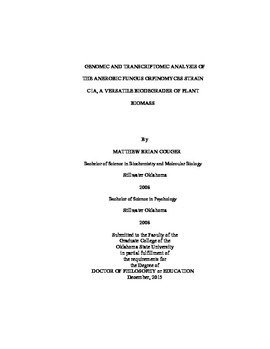| dc.contributor.advisor | Elshahed, Mostafa S. | |
| dc.contributor.author | Couger, Matthew Brian | |
| dc.date.accessioned | 2018-03-13T18:15:32Z | |
| dc.date.available | 2018-03-13T18:15:32Z | |
| dc.date.issued | 2015-12 | |
| dc.identifier.uri | https://hdl.handle.net/11244/54511 | |
| dc.description.abstract | The anaerobic fungi represent a basal fungal lineage, members of which reside in the rumen and alimentary tract of herbivores. Due to their reported capacity to degrade plant materials, the anaerobic fungi have recently been touted as promising agents for biofuel production. In the first part of this thesis, I present the first reported genomic analysis of a member of the anaerobic gut fungi, Orpinomyces sp. strain C1A. The genome of strain C1A was sequenced using a combination of Illumina and PacBio SMRT technologies. The large genome (100.95 Mb, 16,347 genes) displayed extremely low G+C content (17.0%), large non-coding intergenic regions (73.1%), a proliferation of microsatellite repeats (4.9%), and multiple gene duplications. Comparative genomic analysis identified multiple genes and pathways that are absent in Dikarya genomes but present in basal fungal lineages and/or non-fungal Opisthokonts. Analysis of the lignocellulolytic machinery in the C1A genome revealed an extremely rich repertoire, with evidence of horizontal gene acquisition from multiple bacterial lineages. Experimental analysis indicated that strain C1A is a remarkable biomass degrader, capable of simultaneous saccharification and fermentation of the cellulosic and hemicellulosic fractions in multiple untreated grasses and crop residues examined, with the process significantly enhanced by mild pretreatments. | |
| dc.description.abstract | In the second part of my thesis, I analyzed the transcriptomic profiles of C1A when grown on four different types of lignocellulosic biomass (alfalfa, energy cane, corn stover, and sorghum) versus a soluble sugar monomer (glucose). My overall goal was to understand the mechanistic and regulatory basis of biomass deconstruction in anaerobic fungi. Transcriptomic sequencing yielded a total of 468.2 million reads (70.2 GB) that were assembled into 27,506 distinct transcripts. Transcripts belonging to Carbohydrate Active Enzymes (CAZYmes) included 385, 246, and 44 transcripts belonging to 44, 13, and 8 different glycoside hydrolases (GH), carbohydrate esterases (CE), and polysaccharide lyases (PL) families, respectively. Examination of CAZyme transcriptional patterns indicates that strain C1A constitutively transcribes a high baseline level of CAZyme transcripts on glucose. Although growth on lignocellulosic biomass substrates was associated with a significant increase in transcriptional levels in few GH families, including the highly transcribed GH1 B-glucosidase, GH6 cellobiohydrolase, and GH9 endogluconase, the transcriptional levels of the majority of CAZymes families and transcripts were not significantly altered in glucose grown versus lignocelluosic biomass-grown cultures. Further, strain C1A co-transcribes multiple functionally redundant enzymes for cellulose and hemicellulose saccharification that are mechanistically and structurally distinct. Analysis of fungal dockerin domain (FDD)- containing transcripts strongly suggests that anaerobic fungal cellulosomes represent distinct catalytic units capable of independently attacking and converting intact plant fibers to sugar monomers. Collectively, these results demonstrate that strain C1A achieves fast, effective biomass degradation by the simultaneous employment of a wide array of constitutively-transcribed cellulosomal-bound and free enzymes with considerable functional overlap. | |
| dc.description.abstract | The thesis hence represents the first in-depth evaluation of the genome and transcriptome of a member of this poorly studied group of fungi. Collectively, my work has revealed multiple novel insights into the metabolic capabilities, cell biology, and genomic architecture of anaerobic fungi such as the presence of unique pathways and processes not encountered in higher fungi, genomic features shaped by its unique evolutionary trajectory, extensive lignocellulolytic gene repertoire, and regulatory mechanisms employed to achieve fast and efficient biomass degradation within the herbivore gut. | |
| dc.format | application/pdf | |
| dc.language | en_US | |
| dc.rights | Copyright is held by the author who has granted the Oklahoma State University Library the non-exclusive right to share this material in its institutional repository. Contact Digital Library Services at lib-dls@okstate.edu or 405-744-9161 for the permission policy on the use, reproduction or distribution of this material. | |
| dc.title | Genomic and transcriptomic analysis of the anaerobic fungus Orpinomyces strain C1A, a versatile biodegrader of plant biomass | |
| dc.contributor.committeeMember | Prade, Rolf A. | |
| dc.contributor.committeeMember | Marek, Stephen M. | |
| dc.contributor.committeeMember | Shaw, Ed | |
| dc.contributor.committeeMember | Hoff, Wouter | |
| osu.filename | Couger_okstate_0664D_14413.pdf | |
| osu.accesstype | Open Access | |
| dc.type.genre | Dissertation | |
| dc.type.material | Text | |
| thesis.degree.discipline | Microbiology and Molecular Genetics | |
| thesis.degree.grantor | Oklahoma State University | |
